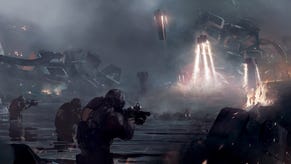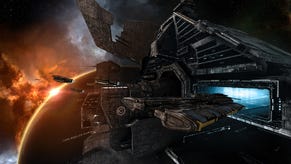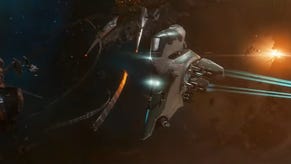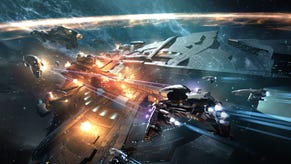10 Years of CCP
The Free Territory of the Americas.
Better red than dead
Pétursson, hands whirling, expounds his theory of "theme park" as opposed to "playground" methods of MMO design. World of Warcraft and Everquest 2 are theme park games, he says, with EVE and Ultima Online sitting in the playground "school". While none of the games are perfect implementations of either approach, EVE, says Pétursson, "emphasises the playground."
Still listening for the pin.
"The analogy is that the theme park is a carefully constructed experience, which is supposed to be fun, condensed, easy to access and is entertainment," he says. "It's really well defined. You never have any doubt about what you have to do. You just wait in line. You go on the rollercoaster, which is fun, then you go out and you go home. The playground is basically just a sandbox. There are toys there. There are more kids than toys, and they usually fight about it. They build sandcastles, but the others just mess them up all the time. There's a nanny there, but she isn't really watching. She's too busy cleaning up the kiddie poop."
On the plus side, you make more friends in the playground. You don't go to Disneyland to make friends, says Hilmar. Also, having friends means you can be collectively more powerful than the kids that are knocking your sandcastles down. Negatively, there are no clear goals - which many find confusing - and there's no true playground hero. Governance is also a problem. "Anarchy leads to despotism," says the presentation slide.
While the playground approach may not lead to the biggest games, being the biggest "was not necessarily the goal". "The goal was to really innovate and to try and do something that's breaking new ground," says Pétursson. "It's been constant pain and struggle, but we really feel as though it's worth something."

He starts talking about social networking, and not just of sites like Facebook and YouTube. Back through history, he says, the Masons and similar groups have been bringing people together in the same way. EVE fuses old and new players, "creating a positive and beneficial relationship between the two groups. And also, when you don't have any shards, you have a big integrated community, and you don't reach a critical mass in terms of really having something that can be called a society. You don't have to break it up into little pockets of 15,000 players with no real connection between them."
EVE, for the sake of clarity, is played on a single server, the largest social software of its type to do so. Games like World of Warcraft, Lineage II, Guild Wars, and so on, are played on servers with number limits, often called "shards". Tranquility, EVE's live server, is housed in a two-ton supercomputer in London which will apparently enter the top 500 list of the world's most powerful computers this year.
Hilmar quotes Metcalfe's law, a theory that states that the value of a telecommunications network is proportional to the square of the number of users of the system. Listening to my recording of the presentation is hilarious. There's not a single sound in that room apart from Hilmar's voice, an occasional cough and me typing.
Rabbits, war, deliberative democracy
"When you make something that's about connecting people together, then each new subscriber increases the value of the application," he says. "For example, your fax machine only has as much worth as the number of fax machines you can send faxes to. The value of MSN is how many people are using MSN. It's not the features of MSN. ICQ, Skype, Yahoo! Messenger: they all do the same, but the value is who's on it. Our belief is that each individual new EVE subscriber really adds value to the people that are already playing the game. So, EVE is a fundamentally better game with 200,000 people than it was with 50,000 people, and it will be an even greater game when it has 300,000 people."
When EVE goes over 300,000 players it will have a bigger population than Iceland. No other game can claim anything like this amount on one server. Hilmar recounts a story of player politics in the first year of EVE's play to give an example of what happens when you have a large population in the same virtual area. It illustrates, he says, "exactly how deep the rabbit hole goes".

In the beginning, EVE's population began to group in areas of "low security" space largely by nationality. In the EVE universe, the central region is "high security" and is known as Empire space. There are four races in EVE - Amarr, Minmitar, Caldari and Gallente - and their Empire home-worlds are all grouped in the centre of the massive play area. This is the most populated part of the map. It's where characters start out, the increased level of protection meaning they're safe (ish) from piracy. As players gather skills and assets, they generally move into lower security space, where rewards are higher but there's no aegis from the NPC police force, Concord.
The universe's southern area was populated by the Scandinavians; the southeast by the Russians; the north by the Americans; and the west by Germany, France and the Benelux region. The Russians had to hack the EVE client because it didn't support Cyrillic script. Once they'd done this, they couldn't speak any other language to anyone, because all anyone with a non-hacked client saw was "boxes and stars and crap". Violence became the only communication available to them, and the Russians were constantly at war with their neighbours, the Scandinavians.
Despite being better organised, having weight of numbers and general tactical advantage, the Russians weren't winning and they couldn't understand why. Turns out the Americans were funding the Scandinavian effort, despite the assertion that they didn't want to get involved in any war and were "just making ships". They'd created supply lines through Empire space, space protected by Concord. The Russians discovered the alliance and convinced the French in the west to attack the Americans and stop the ship supply to the Scandinavians. The Russians then won. The conflict spanned three months and involved 16,000 people.
"I mean, this is a real war," says Pétursson. "It was won on logistics, as all wars are, and for all the people participating it really felt real. And that's the point. When you really allow people to play in the playground, you get meta-patterns and meta-gameplay emerging. It was amazing to follow."
Despotism, monarchy, anarcho-capitalism, democracy, deliberative democracy. Walking on space stations. Replicating the micro-cosmos. Hilmar briefly takes us through the graphical update planned for the coming months. A major content update is coming later this year. The screen says the words:
"EVE's virtual world state is social equity. One shard. It's real."
Hilmar smiles and there's clapping. And I can't help thinking I've seen the groundwork of something gigantic.







